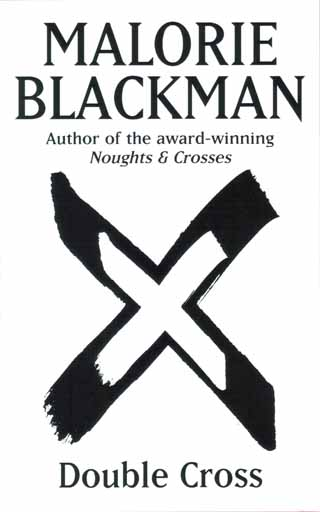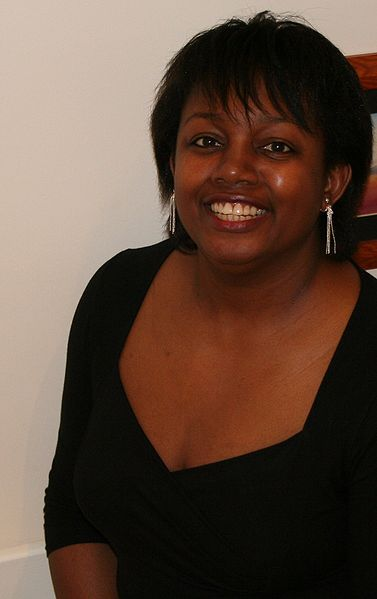Title of the work
Country of the First Edition
Country/countries of popularity
Original Language
First Edition Date
First Edition Details
Malorie Blackman, Noughts & Crosses. London: Doubleday, 2001, 437 pp.
ISBN
Official Website
malorieblackman.co.uk(accessed: March 3, 2020).
Awards
2002 – Red House Children’s Book Award
Genre
Novels
Romance fiction
Target Audience
Young adults
Cover

Retrieved from Wikipedia, uploaded by Aliena. Licensed under CC BY-SA 3.0 (accessed: January 7, 2022).
Author of the Entry:
Sarah F. Layzell, University of Cambridge, sarahlayzellhardstaff@gmail.
Peer-reviewer of the Entry:
Susan Deacy, University of Roehampton, s.deacy@roehampton.ac.uk
Daniel A. Nkemleke, University of Yaoundé 1, nkemlekedan@yahoo.com

Malorie Blackman by Taraforfun. Retrieved from Wikipedia, licensed under CC BY-SA 3.0 (accessed: January 7, 2022).
Malorie Blackman
, b. 1962
(Author)
Malorie Blackman is an award-winning author of over 70 books for children and young adults, including Pig-Heart Boy, the Noughts & Crosses series and the Betsey Biggalow series. She also writes for stage and television, and many of her works have been adapted. Honours for Blackman and her work include the Eleanor Farjeon Award (2005) and an OBE for services to children’s literature (2008). Blackman was the UK Children’s Laureate from 2013–2015, the first Black British writer to hold this position. In late 2019 she announced her forthcoming autobiography, to be published by Stormzy’s Merky Books in 2022.
Sources:
penguin.co.uk (accessed: February 9, 2020);
bbc.co.uk (accessed: February 9, 2020).
Bio prepared by Sarah Hardstaff, University of Cambridge, sflh2@cam.ac.uk
Adaptations
Noughts & Crosses has been adapted for a forthcoming BBC television series, directed by Julian Holmes, produced by Johann Knobe and written by Toby Whithouse, Lydia Adetunji, Nathaniel Price and Rachel De-Lahay. The cast includes Jack Rowan (Callum), Paterson Joseph (Kamal) and newcomer Masali Baduza (Sephy).
Sources:
bbc.co.uk(accessed: February 9, 2020);
imdb.com(accessed: February 9, 2020).
Noughts & Crosses has also been adapted for the stage multiple times, most recently by Sabrina Mahfouz.
Sources:
pilot-theatre.com (accessed: February 9, 2020);
theguardian.com (accessed: February 9, 2020).
Translation
French: Entre Chiens et Loups, trans. Amélie Sarn, Éditions Milan, 2005.
French (graphic novel): Malorie Blackman, Ian Edginton and John Aggs, Entre Chiens et Loups, trans. Marion Roman, BD Kids, 2016.
German: Himmel und Hölle, trans. Christa Prummer-Lehmair, Fischer-Taschenbuch-Verl.,2010.
Italian: Il bianco e il nero, trans. Michela Proietti, Rizzoli, 2011.
Japanese: コーラムとセフィーの物語 : 引き裂かれた絆 [Koramu to sefi no monogatari: Hikisakareta kizuna], transl. Hoshi Tominaga, Popurasha.
Spanish: Blanco y negro, trans. Efrén Valle and Verónica Rueda, Medialive Content, 2009.
Sequels, Prequels and Spin-offs
Noughts & Crosses is the first of five novels in the series: the sequels are Knife Edge (2004), Checkmate (2005), Double Cross (2008) and Crossfire (2019). Blackman has also written two novellas to accompany the series: Callum (written for World Book Day 2012) and An Eye For an Eye (written for World Book Day 2003).
Summary
Sephy Hadley and Callum McGregor are best friends as children, but they live in a world where dark-skinned Crosses like Sephy dominate every aspect of society while the pale-skinned Noughts like Callum are oppressed. The history behind this oppression hints at an inversion of the power dynamics of classical history. Meanwhile, both Sephy (‘Persephone’) and her sister, Minerva, have classically-inspired names, recalling the Ancient Greek queen of the Underworld and the goddess of wisdom.
The narrative switches back and forth between Sephy and Callum, giving perspectives from both sides of society. The novel opens with Callum’s mother losing her job working for the Hadleys. Shortly afterward, Callum’s sister Lynette is attacked and is never the same again, retreating into herself and experiencing delusions that she is a Cross.
Three years later, Callum starts attending Sephy’s school, as one of only a handful of Nought students. Lynette dies by suicide and Callum’s brother Jude and father Ryan join the Liberation Militia, a terrorist organisation fighting for Nought rights. Jude plants a bomb at a local shopping centre which kills several people; his father Ryan confesses to the crime and is sentenced to death. Meanwhile, Sephy’s parents, alcoholic Jasmine and high-ranking politician Kamal, have separated. Her own relationship with Callum is increasingly characterised by mistrust and misunderstanding. The pair miss an opportunity to declare their feelings for one another and Sephy leaves for boarding school.
As the narrative jumps forward in time, Callum has joined the Liberation Militia and worked his way up the ranks. With his brother Jude, he is tasked with kidnapping Sephy and holding her hostage. While Sephy is Callum’s prisoner, they have sex, after which she escapes with Callum’s help. Callum is arrested and executed, after both Callum and Sephy reject a deal proposed by Kamal that the death sentence be waived if Sephy terminates the pregnancy. The novel ends with the birth announcement of Sephy and Callum’s daughter, Callie Rose McGregor, whose story continues in the sequels.
Analysis
The names of Sephy (short for Persephone) and her older sister Minerva are the novel’s most overt classical references. Blackman has commented on her choice of names for the characters, saying that the Demeter and Persephone story is “one of my favourites… I hasten to add, Noughts and Crosses isn’t a retelling of that story – apart from Sephy getting abducted” (2016).
Minerva’s name is an amusing choice: her ‘wisdom’ takes the form of a tendency to gossip and revel in her access to insider information. The connections between Sephy and her classical namesake are more complex. Holly Blackford has written about the ways in which girls’ fantasy literature rewrites the Persephone myth, with an emphasis on breaking away from the mother and becoming sexually aware; at the same time, the Persephone character is “fated forever to cycle between worlds” (2012, 1). Noughts & Crosses features many examples of stories of descent and return from the underworld.
Sephy makes a number of symbolic journeys to the underworld: first, when she visits Callum’s home after Lynette’s funeral. She is unprepared to face a room full of unwelcoming Noughts, one of whom was fired by her mother as a direct consequence of Sephy’s self-centred and naïve perspective. She reflects afterwards that “Every move I made in Callum’s direction just seemed to pave my way faster to hell.” (Blackman 2001, 172). The imagery of hell and an unreal world is evoked again when Sephy and Callum have sex: “Beside him all the way as he led me into a real, unreal world. Not quite heaven. Not quite hell.” (377) (In fact, the German translation of the novel is titled Himmel und Hölle [Heaven and Hell]). The cabin where Sephy is held hostage has the same feel of displacement from society as the underground tunnels where Callum has lived during his apprenticeship in the Liberation Militia, his own story of descent into hell.
Callum’s sister Lynette also retreats from society but is then forced to re-emerge after a violent confrontation with Jude. Callum later reflects, “She’d been pulled out of her unreal world too soon.” (418). The sense of an inverted world is also felt at the level of the relationship between the story-world and the readers’ world. Blackman uses many real-life examples of racism and real historical figures in the novel, drawing attention to her inversion of black and white in ways that prompt the reader to question their own world more thoughtfully and critically.
A further parallel with Greek mythology can be read into the circumstances of Sephy’s pregnancy. Clémentine Beauvais discusses Sephy’s pregnancy alongside that of Bella from the Twilight series, finding similarities with the story of Pasiphae, mother of the Minotaur. In each case, “the hybrid baby […] represents potential socio-political change and will be a visible embodiment of transgressive love.” (2012, 65) Beauvais also argues that in Noughts & Crosses and Twilight, sex is “equally violent, equally ambiguous, and equally political” as in the Pasiphae myth. Although compelling, this interpretation ultimately distracts from Blackman’s construction of Sephy and Callum’s relationship, their mutual insistence on his innocence of the charge of rape and the intruding violence of a vengeful racist society that is all too eager to believe and amplify false allegations.
Alongside Blackman’s inversions and interrogation of more recent history, she also hints at an inversion of classical history. Catherine Butler points out that Sephy and Callum’s history teacher asks the class to name “one of the significant events of the year 146 BC” (Blackman, 65). Butler interprets this reference as a “branch point” in the counterfactual history of the novel: “In our world this was the year of the Third Punic War, in which Rome finally destroyed its African rival, Carthage.” (Butler 2017, 189). Thus it is possible that in Sephy and Callum’s world, the outcome of the war was inverted, and 146 BC is significant because this is the point at which “the balance of power tip[s] decisively to Africa from Europe” (189). As Butler points out, this is one of many techniques used in the novel to show that “our world’s recent centuries of white dominance are a contingent rather than an inevitable historical outcome” (190); in other words, there is nothing natural about our current racial hierarchies and things could have been different.
Further Reading
Beauvais, Clémentine, “Romance, Dystopia, and the Hybrid Child”, in Mary Hilton and Maria Nikolajeva, eds., Contemporary Adolescent Literature and Culture: The Emergent Adult, Farnham: Ashgate, 2012, 61–76.
Blackford, Holly V., The Myth of Persephone in Girls’ Fantasy Literature, New York, NY: Routledge, 2012.
Blackman, Malorie, “Noughts and Crosses Q&A”, malorieblackman.co.uk, 21 Jun 2016 (accessed: December 5, 2019).
Butler, Catherine, “Counterfactual Historical Fiction for Children and Young Adults”, in Clémentine Beauvais and Maria Nikolajeva, eds., The Edinburgh Companion to Children’s Literature, Edinburgh: Edinburgh University Press, 2017, 179–193.
Pinsent, Pat, “Language, Genres and Issues: The Socially Committed Novel”, in Catherine Butler and Kimberley Reynolds, eds., Modern Children’s Literature: An Introduction, New York, NY: Macmillan, 2014, 137–152, 2nd edition.
Sands-O’Connor, Karen, Children’s Publishing and Black Britain, 1965–2015, New York, NY: Palgrave Macmillan, 2017.


